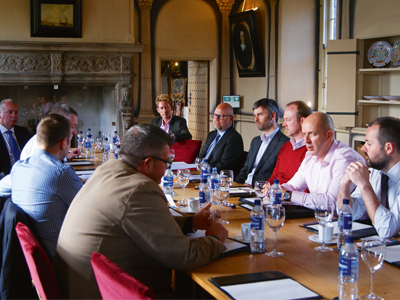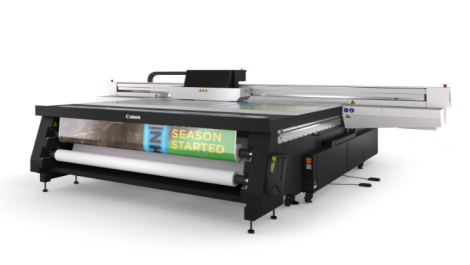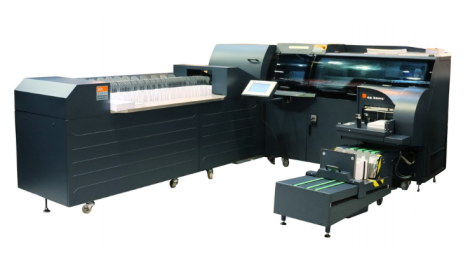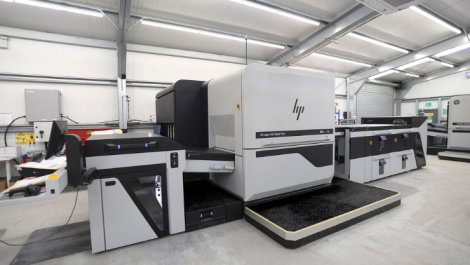Is new technology adoption seen as a route into new markets or a way to increase production efficiency? This was a key topic as a select group of Scottish printers gathered at Stirling Castle for a Strategies For Success roundtable event. Andy Knaggs reports.
There is a fine view to be had from on high at Stirling Castle, although perhaps not so fine to English eyes as others, with the battlefield of Bannockburn and the National Wallace Monument, commemorating another even earlier English reverse, laid out in the fields and hills around.
If you want to inspire a Scotsman to talk though, then there is possibly no better place, save for the soaring stands at Hampden Park or Murrayfield. So it was to Stirling Castle that Digital Printer and its partner Ricoh headed for the latest Strategies For Success round table event, with some of Scotland’s leading printing business decision makers invited to discuss the theme of Responsible Technology Adoption.
Subjects covered were views on investment, diversification, how manufacturers can help, and how access to funding is developing. A talkative half dozen made it to Stirling for the discussion: Alun Joseph (Digital Typeline Publications); David Willis (The Adwill Partnership); Innes Reid (Exactaprint); John Griffiths (MC Squared); Murray Alexander (XIC); and Scott Johnston (Johnston Mailing). See the boxout on page ??? for a little more about each company.
Following introductions, the question was posed: what are the factors that go into evaluating possible technology investments? Alun Joseph observed that his company’s recent investment in a Ricoh press meant that it had cheaper production and cheaper machine leases. The investment was therefore ‘essentially a saving for us; investment can save you money when done the right way; it’s not necessarily about driving new business’.
It was partly in response to this that John Griffiths said: ‘The way we look at investment is that we have a need to. The current kit needs to be replaced. Do we go like for like? It’s true you can make an investment and make savings as well, especially with toner digital. If there are good add-ons that also sell that’s fantastic, but it’s about replacement machines that there is already work there for. We are looking at the little 5 or 10% that a machine can do, compared to the other ones. Click charges, maintenance, servicing, these are obviously key to the calculation, but it is replacing current requirement for us.’
It was a similar story for David Willis, who has very recently bought a new digital press – Ricoh’s Pro C7100X. He said: ‘We needed it to handle what we’ve currently got and it will help us to diversify a bit to the clients we have. We will use it as a sales tool also. Efficiency savings…that all goes into the mix of finance and how we will do that.’
He added another point too: ‘We looked over the last four years at what it had been cost-wise with the in-situ digital kit. We have got this new press: we needed to buy it, but it is working out where it is adequate. You are not dealing with a professional print buyer now. We are problem solvers now.’
This prompted Alun Joseph to observe: ‘That is where our investment in MIS comes in: to be able to look back and see what we quoted on or outsourced. That information is now starting to come through and it has already proved useful. We know how much money we would get over the year in putting in new presses. Having that historical information is invaluable. We have got to look back at what saving it will make in efficiency, or what work we might get that we have missed before.’
For Innes Reid of city centre printer Exactaprint, space is of the essence, so the footprint of any new technology is an important consideration. He said it made sense to invest to bring processes in house, so that the company could save on logistics. ‘With the digital boxes, we run them to the end of their lives. If people want white ink we can get it done. We used to buy the machines upfront and just have servicing, but the machine becomes so old and the quality not what it should be.’
Service is key
When looking at investing in a new press, Aberdeen’s XIC was looking for ‘something affordable and versatile’, said Murray Alexander, adding: ‘We are using it for quality and speed.’ He also related a story about the company’s experience with a digital equipment reseller which takes us nicely into the role that print firms want to see the manufacturers play.
XIC had been working with a reseller for small colour printers, and when these were exhausted the reseller suggested XIC take the first Canon imagePress to advance itself on the digital side, based on a quarterly rental package with no minimum billing. It seemed that the numbers stacked up, so XIC took the imagePress. There were quality benefits but having a brand new machine supported by a local reseller was problematic. The firm took a second device to support the first, allowing it to stabilise the situation and satisfy client needs.
Mr Alexander continued: ‘As we became more proficient and pushed the digital side we needed more exposure to Canon on how to sell it, and the reseller did not have that. We went with Canon direct and we will never deal with a reseller again. Service is absolutely key for us, being so far north. Preventative maintenance is also key for us. We frequently run jobs over the weekend. Quarterly rental was a new thing for us but it works, provided you get the right deal. It allows us to replenish the kit and stay up there.’
As Mr Alexander alluded to, geography – not something that too many English printers need to be too concerned about – can be a problem for Scottish printers. ‘If we have a problem, to get real expertise we are looking at bringing someone up from Leeds,’ said David Willis.
Another issue raised by Mr Alexander is that of being the first to use a new technology. Some companies love to do this, and do not mind being the first to hit the bumps in the road; others like nothing less. Scott Johnston of Johnston Mailing has experienced it and bears the scars. He said: ‘We took the pain of having the first of a poly machine, 40 feet long, in Britain: there were 19 software upgrades in three weeks. It was just hell. Do you want to buy the first of its kind? We have realised that, actually, let’s just buy the third one and not shout about it. You buy the first one looking for increased speed and reliability: that comes after six months.’
The relationship in general between printer and equipment supplier needs to be more of a partnership than David Willis experienced when he was looking to invest. He found that with the exception of two potential suppliers – one of whom got the order – the sellers did not seem to want to ask questions and find out about the business. These companies ‘all tried to sell us something that we did not need’, he said, adding: ‘They didn’t look at the business and find out about it. That’s very important for us. There has got to be a partnership there.’
Potentially losing work to equipment manufacturers that are also directly competing in the market for printing contracts was another concern raised, and there was also a feeling that manufacturers will sell the latest equipment as a must-have without sticking around to help the printer actually make that new technology be profitable – or as John Griffiths put it: ‘Certain manufacturers say you need to have that new technology, but we are the ones that have to go and sell that to the customer, and the manufacturers have washed their hands of it.’
Alun Joseph recognises this scenario. ‘You can really feel that you have to do something because the guy down the road is. There’s a lot of excitement in the industry, new stuff in the magazines, trade shows, there’s always something. As printers, I think we have a lot of engagement in what’s happening as well. The trick is keeping calm and interpreting that for your business individually. It’s easy to say we will diversify into this market or this product, but do your markets want that? You have to filter out what’s not for you. We are all really well informed about what’s out there.’
Funding options do seem to be opening up however. Again, Alun Joseph: ‘We are starting to get calls from people asking if we are looking to buy something. There’s irony here, but the bank manager is calling. It is definitely easing up, if the risk is perceived as low enough.’
David Willis raised finance for his recent purchase but got ‘fed up jumping through hoops’ to achieve it. He added: ‘Just having a robust set of figures is not enough for a lot of people.’
When it bought a polywrapping line from a competitor that was going out of business, Johnston Mailing used Regional Selective Assistance, a grant scheme from Scottish Enterprise. It bought the line with no volume in place but had to give guarantees on staffing levels to qualify for the grant.
‘It took us two to three years to fill that line. We would have been better saying no to the grant, buying the line and adding staff as needed. We then asked the Scottish Executive if we could tender for work, but they tendered to a design agency in Edinburgh that used the big boys down south. And we had the biggest line in Scotland.’
In closing the round table, Ricoh’s Tim Carter told the participants that the manufacturer recognised the importance of it continuing to try to understand what its customers and prospects want in technology. ‘A message that came loud and clear was being able to develop a strategic alliance with your customer and having common goals aligned to growth and profitability in the future. That’s something we are striving to do.’
The panel
John Griffiths (MC Squared) – a mostly digital printer with HP Indigo and toner engines, plus some litho, which pitches itself into the short run market. It has premises in Edinburgh and Glasgow. Comment: ‘We are looking to invest in the very near future in new technology. It’s about diversification and being more cost effective than currently. Our biggest thing is being an extension of the client’s marketing department. They want to be more diverse in what they print, and messaging can change every 24 hours.’
David Willis (The Adwill Partnership) – a predominantly litho printer in Glasgow that uses digital print as a back-up, the company has a wide range of clients in corporate, academia, tourism and charity. It has just invested in a Ricoh Pro C7100 system with white ink and long banner capability. Comment: ‘It’s the cost of doing something versus the cost of not doing something. We see digital investment as something that will enhance our offering. I would say now is a good time, especially with changes on the digital side of things; that’s where you are going to win work.’
Innes Reid (Exactaprint) – a long established city centre print and design company in Glasgow, using Ricoh and Xerox machines. It has a public counter so gets a wide range of customers. Comment: ‘The majority is short run digital work that people need there and then, so we had to invest in more finishing – laminating, binding, creasing – which we used to have to outwork; you just don’t have time to send it out now.’
Murray Alexander (XIC) – the Aberdeen company has both litho and digital, wide format, finishing, creative services and marketing services. Comment: ‘The investment has been very canny and has always been in line with our volume. Had it not been for digital investment the company would probably not be here or would be very much smaller. It has been a life saver and there will be no litho investment going forwards.’
Scott Johnston (Johnston Mailing) – a mailing house that provides a full spectrum of direct mail services from sites in Edinburgh and Glasgow, including print, envelope inserting and polywrapping. Comment: ‘At Ipex I sat with some printers and said, do we all chip in and get a B2 digital? There aren’t the volumes yet but there might be in 18 months. We don’t go to the magazines every time we invest; we just keep our heads down and keep spending.’
Alun Joseph (Digital Typeline Publications) – exclusively digital printer in Edinburgh using Ricoh systems, along with some large format. Eighty percent of its work is in the niche market of printed property brochures for estate agents. Comment: ‘Diversification is great but with caution for us. It’s about catching someone’s eye with something new, but when you are through the door it is selling what you are about as a business, your ethos, what you will look after them with. The market is there for getting into new things and I think we have to.’





